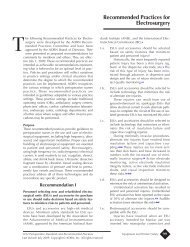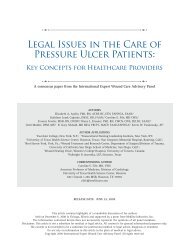2D.5. Maintain unobstructed urine flow. (Category IB)2D.6. Further research is needed on the benefit of spatial separation of patients with urinarycatheters to prevent transmission of pathogens colonizing urinary drainage systems. (Norecommendation/unresolved issue)2D.7. When per<strong>for</strong>ming surveillance <strong>for</strong> <strong>CAUTI</strong>, consider providing regular (e.g., quarterly)feedback of unit-specific <strong>CAUTI</strong> rates to nursing staff <strong>and</strong> other appropriate clinical care staff.(Category II)Q3: What are the best practices <strong>for</strong> preventing UTI associated withobstructed urinary catheters?The available data examined the following practices:1. Methods to prevent/reduce encrustations or blockage2. Catheter materials preventing blockageFor this question, available relevant outcomes included blockage/encrustation. We did not finddata on the outcomes of <strong>CAUTI</strong>. The evidence <strong>for</strong> this question consists of 1 systematicreview, 277 2 RCTs, 278,279 <strong>and</strong> 2 observational studies. 280,281 The findings of the evidence review<strong>and</strong> the grades <strong>for</strong> all important outcomes are shown in Evidence Review Table 3.Q3.1. Methods to prevent/reduce encrustations or blockageLow-quality evidence suggested a benefit of acidifying solutions or oral acetohydroxamic acid inpreventing or reducing catheter encrustations <strong>and</strong> blockage in long-term catheterizedpatients. 277,278,280,281 No differences were seen with daily catheter irrigation with normal saline.Q3.2. Catheter materials preventing blockageLow-quality evidence suggested a benefit of silicone over latex or Teflon-coated catheters inprevention or reducing catheter encrustations in long-term catheterized patients who were proneto blockage. No differences were seen with different materials in patients considered “nonblockers.”279Evidence Review Table 3. What are the best practices <strong>for</strong> preventing UTI associated withobstructed urinary catheters?3.1.a. Further research is needed on the benefit of irrigating the catheter with acidifyingsolutions or use of oral urease inhibitors in long-term catheterized patients who have frequentcatheter obstruction. (No recommendation/unresolved issue)3.2.a. Silicone might be preferable to other materials to reduce the risk of encrustation in longtermcatheterized patients who have frequent obstruction. (Category II)48
References1. Wong ES. Guideline <strong>for</strong> prevention of catheter-associated urinary tract infections. Am J Infect <strong>Control</strong>. 1983;11(1):28-36.2. Lo E, Nicolle L, Classen D, et al. Strategies to prevent catheter-associated urinary tract infections in acute care hospitals. Infect <strong>Control</strong> Hosp Epidemiol.2008;29:S41-S50.3. Stephan F, Sax H, Wachsmuth M, Hoffmeyer P, Clergue F, Pittet D. Reduction of urinary tract infection <strong>and</strong> antibiotic use after surgery: A controlled,prospective, be<strong>for</strong>e-after intervention study. Clin Infect Dis. 2006;42(11):1544-1551.4. Dolin SJ, Cashman JN. Tolerability of acute postoperative pain management: Nausea, vomiting, sedation, pruritis, <strong>and</strong> urinary retention. evidence frompublished data. Br J Anaesth. 2005;95(5):584-591.5. Hidron AI, Edwards JR, Patel J, et al. NHSN annual update: Antimicrobial-resistant pathogens associated with healthcare-associated infections: Annualsummary of data reported to the national healthcare safety network at the centers <strong>for</strong> disease control <strong>and</strong> prevention, 2006-2007. Infect <strong>Control</strong> Hosp Epidemiol.2008;29(11):996-1011.6. Saint S. Clinical <strong>and</strong> economic consequences of nosocomial catheter-related bacteriuria. Am J Infect <strong>Control</strong>. 2000;28(1):68-75.7. Platt R, Polk BF, Murdock B, Rosner B. Mortality associated with nosocomial urinary-tract infection. N Engl J Med. 1982;307(11):637-642.8. Givens CD, Wenzel RP. Catheter-associated urinary tract infections in surgical patients: A controlled study on the excess morbidity <strong>and</strong> costs. J Urol.1980;124(5):646-648.9. Tambyah PA, Knasinski V, Maki DG. The direct costs of nosocomial catheter-associated urinary tract infection in the era of managed care. Infect <strong>Control</strong> HospEpidemiol. 2002;23(1):27-31.10. Schaberg DR, Weinstein RA, Stamm WE. Epidemics of nosocomial urinary tract infection caused by multiply resistant gram-negative bacilli: Epidemiology <strong>and</strong>control. J Infect Dis. 1976;133(3):363-366.11. Yoon HJ, Choi JY, Park YS, et al. Outbreaks of serratia marcescens bacteriuria in a neurosurgical intensive care unit of a tertiary care teaching hospital: Aclinical, epidemiologic, <strong>and</strong> laboratory perspective. Am J Infect <strong>Control</strong>. 2005;33(10):595-601.12. Warren JW. Catheter-associated urinary tract infections. Int J Antimicrob Agents. 2001;17(4):299-303.13. Weinstein JW, Mazon D, Pantelick E, Reagan-Cirincione P, Dembry LM, Hierholzer WJ,Jr. A decade of prevalence surveys in a tertiary-care center: Trends innosocomial infection rates, device utilization, <strong>and</strong> patient acuity. Infect <strong>Control</strong> Hosp Epidemiol. 1999;20(8):543-548.14. Munasinghe RL, Yazdani H, Siddique M, Hafeez W. Appropriateness of use of indwelling urinary catheters in patients admitted to the medical service. Infect<strong>Control</strong> Hosp Epidemiol. 2001;22(10):647-649.49
- Page 4 and 5: AcknowledgementHICPAC thanks the fo
- Page 6 and 7: AbbreviationsADLAPACHE IIASAASBBUNC
- Page 8 and 9: I. Executive SummaryThis guideline
- Page 10 and 11: II. Summary of RecommendationsTable
- Page 12 and 13: II. Proper Techniques for Urinary C
- Page 14 and 15: 1. If obstruction is anticipated, c
- Page 16 and 17: a. Procedure-specific guidelines fo
- Page 18 and 19: III. Implementation and AuditPriori
- Page 20 and 21: IV. Recommendations for Further Res
- Page 22 and 23: V. BackgroundUrinary tract infectio
- Page 24 and 25: acteriuria inevitably occurs over t
- Page 26 and 27: VII. MethodsThis guideline was base
- Page 28 and 29: Figure 2: Results of the Study Sele
- Page 30 and 31: After determining the GRADE of the
- Page 32 and 33: Category I recommendations are defi
- Page 34 and 35: VIII. Evidence ReviewQ1. Who should
- Page 36 and 37: Evidence Review Table 1B. What are
- Page 38 and 39: Very low-quality evidence suggested
- Page 40 and 41: Q2B.2. Hydrophilic catheters vs. st
- Page 42 and 43: For all comparisons, we considered
- Page 44 and 45: a. Clamping vs. free drainage prior
- Page 46 and 47: studies. 3,25,260-276 The findings
- Page 50 and 51: 15. Jain P, Parada JP, David A, Smi
- Page 52 and 53: 44. Chaudhuri P, Vengadasalam D. Ur
- Page 54 and 55: 71. Kelleher RE, Meeropol E, Parks
- Page 56 and 57: 101. Hirsh DD, Fainstein V, Musher
- Page 58 and 59: 132. Van Nagell, JR, Penny RM, Rodd
- Page 60 and 61: 163. Lai KK, Fontecchio SA, Lai KK,
- Page 62 and 63: 193. Waites KB, Canupp KC, Armstron
- Page 64 and 65: 222. Cohen A. A microbiological com
- Page 66 and 67: 253. Chavigny KH. The use of polymi
















